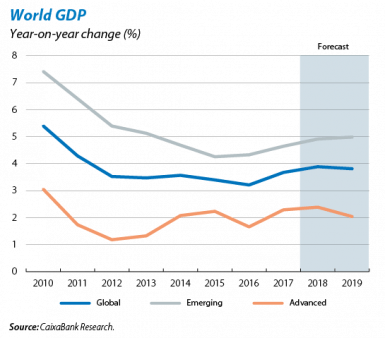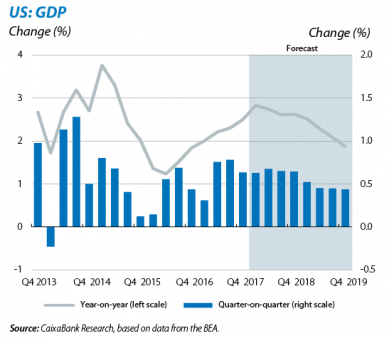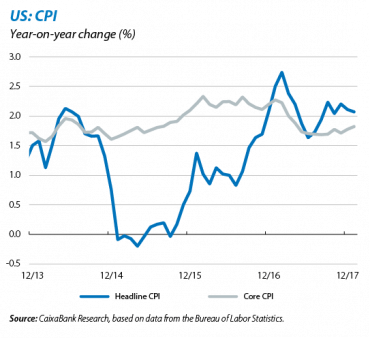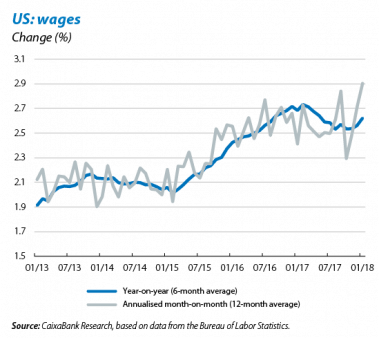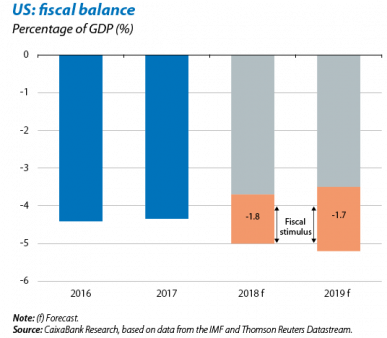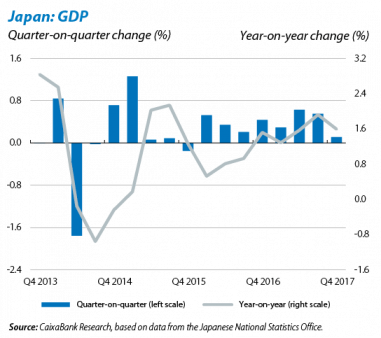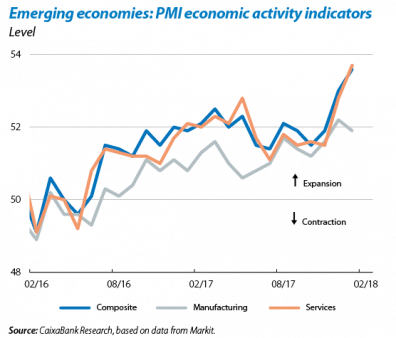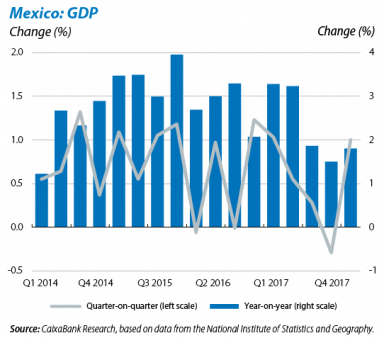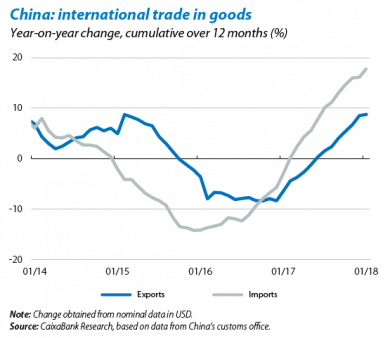The global economy keeps its momentum going at the start of the year
Global economic activity indicators continue to look positive in Q1 2018. The data released has been really positive in the early part of the year. One case in point is the (PMI) composite global business sentiment index which, in January, reached its highest level since March 2011. More importantly, this positive trend is widespread and occurring in both the advanced and emerging countries. These positive trends bolster the outlook of CaixaBank Research which forecasts a moderate growth accelerationfrom the 3.7% estimated in 2017 up to 3.9% in 2018. The factors supporting this sanguine scenario have not changed: Financial conditions will remain accommodative (normalisation is expected to remain gradual, even in the US), oil prices will stay within a reasonable range which will help exporting countries but without harming importers (In fact, the recent stabilisation of oil slightly below USD 70 per barrel indicates a limited recovery in prices),and the good growth prospects for the emerging economies will intensify owing to the cruising speed of emerging Asia and the gradual recovery in Russia and Brazil.
Nevertheless, there are still risks. One considerable source of risk is the possibility of further corrections in financial markets. The correction originating in the US last month was not big enough to modify the favourable outlook for the world economy. However, the factors behind this correction (increased expectations of interest rate hikes, rising inflation, a potentially overvalued stock market and amplification due to automated trading) will still be very much present over the coming months. We will therefore have to keep a close eye on possible further corrections and their impact on global economic activity. There are also sources of geopolitical risk (for an in-depth analysis, see the Focus «Geopolitical uncertainty and economics: Deep impact?» in this Monthly Report). On the one hand, a clear victory by Eurosceptic parties and populists in the Italian elections on 4 March would reduce the leeway to promote the desired economic reforms in the euro area. And, on the other side of the Atlantic, there is the risk of NAFTA negotiations not being completed in Q1. This could lead to a stalemate and exacerbate political polarisation in the US and Mexico given the intense electoral calendar this year (July’s presidential elections in Mexico and November’s mid-term elections in the US).
UNITED STATES
Growth prospects improve thanks to a tax boost larger than expected. Early in February, Congress passed a law to raise federal spending levels in 2018 and 2019 with particular emphasis on defence. The increase in budget is slightly more than expected, with an estimated impact of around +0.2 pp on the US economy’s growth, both in 2018 and 2019. We have therefore increased our 2018 growth forecast from 2.4% to 2.7% (the remaining 0.1 pp can be explained by the robust GDP data published for Q4 2017) and, for 2019, from 2.0% to 2.2%.
Inflation surprises to the upside in January. Specifically, inflation remained at 2.1% year-on-year in January, the same figure as December. However, this was notably higher than the CaixaBank Research forecast (1.8%) and those of most analysts. It is remarkable that the rise in the price index was generalised in most of its components . This trend, in addition to substantial growth in wages (2.9%), points to a phase with greater price tensions in 2018, especially from Q2 onwards (with inflation potentially reaching 3% in some months). Given these inflation figures and the upward revision of GDP, we have raised our inflation expectations for 2018 (from 2.2% to 2.6%) and 2019 (from 2.0% to 2.1%). Inflation dynamics are very important for the US economy and directly affect monetary policy, since higher than expected inflation could lead to faster interest rate hikes by the Fed. This context endorses our monetary normalisation scenario of now four (previously three) interest rate hikes in 2018.
Full-speed ahead for the US economy at the start of the year. All the latest economic activity figures seem to point to strong growth in Q1 2018. The labour market looks particularly dynamic with 200,000 jobs created in January, an even more impressive figure considering how close the US economy is to full employment. The economic and business sentiment indicators were also strong, posting very good figures. For instance, the consumer confidence index produced by the prestigious University of Michigan was close to its peak for this new expansionary cycle.
Fiscal stimulus: a double-edged sword? The fiscal stimulus resulting from increased spending adds to other expansionary measures such as tax cuts and higher spending on infrastructures, which were already known. Such measures have a relatively moderate and limited impact on economic growth as the economy is in a mature phase of the cycle in which it does not seem to be in any great need of further stimuli. However, it is estimated that all these policies as a whole (i.e. tax cuts and increased spending) will raise the fiscal deficit to GDP ratio by 1.3 pp in 2018 and by 1.7 pp in 2019, resulting in a fiscal deficit of around –5% of GDP in 2018 and 2019. This higher public deficit is not good news as it could imbalance the public accounts and push up public debt and generate inflationary tensions.
JAPAN
The Japanese economy looks resilient. In Q4 2017, Japan’s economy slowed down (growing by 0.1% quarter-on-quarter compared with 0.6% in Q3) but remained in positive figures. This is the eighth consecutive quarter of growth, something last achieved in 1989. The recovery in private consumption is particularly important, given its decline the previous quarter. We expect 1.3% growth year-on-year for 2018, considerably higher than the country’s estimated growth potential of between 0.5% and 1%.
EMERGING ECONOMIES
The emerging economies flex their muscles. On the whole, the emerging economies continue to post substantial growth in economic activity. This can be seen in the latest macroeconomic data as well as business sentiment indices. The composite PMI for the emerging economies has climbed to 53.6 points, way above the 51 points recorded on average over the past two years. The different economic activity indices, such as the one produced by the IIF, also point to momentum for the emerging economies. Nevertheless, the decline in Asian stock markets after the US correction and recent capital outflows suggest that tighter than expected monetary policy in the US could harm the good performance of the emerging economies.
China: very calm before an intense month. The different economic activity data (PMI, trade data...) indicate that the Chinese economy has started the year as solid as it ended 2017. However, the latest figures must be interpreted with caution as they partly reflect distortions caused by the festivities for the Chinese New Year (falling in mid-February in 2018 but at the end of January in 2017). The composition
of the new National People’s Congress will soon be revealed. This is the country’s highest legislative body and it will hold its annual session early in March, when the growth target for 2018 will be disclosed. The most outstanding news this month has been the Communist Party’s proposal to eliminate the country’s presidential term limits. This would pave the way for Xi Jinping to prolong his leadership beyond 2022 should the Assembly approve the proposal.
Mexican economy rebounds in a really complex environment. In Q4 2017, Mexico’s growth accelerated to 1.0% quarter-on-quarter (1.8% year-on-year) compared with a 0.3% decline the previous quarter. The growth figure is slightly higher than expected but a large proportion of the increase is due to the effect of the atypical decline the previous quarter, caused by temporary factors (earthquakes and hurricanes). In annual terms Mexico grew by 2.1%. The outlook im the upcoming quarters will be hindered by the uncertainty of presidential elections this July and doubts regarding the NAFTA negotiations.
Russia comes out of its decline while India shines again. The recovery of the Russian economy explains S&P’s decision to upgrade Russian debt and lift it out of «junk bond» territory. However, the agency has warned that the country’s dependence on revenue from oil and gas exports, international sanctions in a complicated geopolitical context and institutional weaknesses will constrain growth in the medium term (for more detail, see the Focus «Russia’s economic outlook: politics (not business) as usual» in this Monthly Report). India, however, has recovered its brilliance and finally left behind the temporary shocks that had hindered its growth in the first three quarters of 2017. With 7.2% growth in Q4, the Indian economy is in an unbeatable position to accelerate again in 2018.
